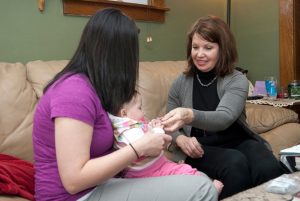For 40 years, an intervention program called the Nurse-Family Partnership has been sending public health nurses to visit first-time, low-income mothers to encourage healthy behaviors and offer advice on child development.
Three randomized-controlled trials have found mothers who participate in the program are less likely to smoke and have high blood pressure, more likely to be employed and less likely to use government assistance programs such as welfare. And children who participate are less likely to be born preterm, less likely to suffer child abuse and neglect, more likely to show improvements in cognitive and language development, and less likely to be involved with criminal activities compared to children not in the program.
A systematic review and economic analysis of the program published in 2015 calculated that by 2031, the program will have prevented an estimated 500 infant deaths, 10,000 pre-term births, 4,700 abortions, 42,000 child maltreatment incidents, 36,000 intimate partner violence incidents, 36,000 youth arrests, and 41,000 person-years of youth substance abuse.
Now a new study published in the journal Child Maltreatment takes a deeper look into how the program helps to prevent child abuse and neglect. For the study, researchers interviewed 357 mothers 15 years after they first participated in the Nurse-Family Partnership. Researchers also accessed reports from Child Protective Services for the participating families.
The new analysis found that children who participated in the program were 4 times less likely to experience child abuse and neglect – and that benefit held up even when mothers reported experiencing low to moderate levels of domestic violence.
But why? Based on interviews and data analysis, the researchers believe there are two outcomes of the program that help prevent child abuse and neglect in the long-term.
First, nurses in the program counsel mothers about planning future pregnancies to allow their bodies to recover from childbirth and ensure they are able to meet their personal goals. As a result, participating mothers had fewer children overall and tended to have longer intervals between pregnancies. Combined results from three randomized-controlled trials found mothers in the program were nearly 40 percent less likely to have a second child within 24 months compared with mothers who did not participate.
Second, nurses help the mother to feel empowered to make sound choices about her education, workplace participation, and partner relationships that enable her to financially take better care of herself and her child. As a result, mothers are less likely to use public assistance such as food stamps and welfare. And they are more likely to be employed and economically self-sufficient.
“Our findings confirm other studies that point to large family size and poverty as risks for child maltreatment,” said John Eckenrode, professor of human development Cornell University, lead author of the study and director of the National Data Archive on Child Abuse and Neglect. “Helping mothers to achieve their personal goals and become self-sufficient leads to long-term improvements in parenting, and that reduces the chances of child maltreatment.”
The take-home message? Having nurses coach low-income mothers pregnant with their first child to achieve their personal goals and plan future pregnancies can yield multiple benefits to the mothers and their children, including a reduction in the incidence of child abuse and neglect.




Speak Your Mind